St.Patrick’s Day in London
1950s – 1960s
Parades on St. Patrick’s Day in central London emerged following the end of World War II and through the early 1950′s. It was through the St. Patrick‚Äôs Day Parade where members of County Associations would meet up with their fellow county men and women walking behind their county banners in an affirmation of their Irish identity.
Although Irish emigration to England took place over many decades, it reached its highest level for a century in the 1950s (Meath Association of London, 2008). The massive post war reconstruction programme in Britain presented employment opportunities for large numbers of Irish construction workers and nurses to staff the newly formed NHS (National Heath Service).
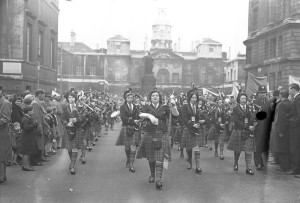
Thousands of mainly young Irish migrants arrived monthly without friends or family, much money or a place to stay. The vast majority were lonely living out of bedsits or hostels with only the pub and dance hall as a place to meet (Clare Association London, 1979).
It was at this time that many County Associations were formed, to provide a support network and to help people integrate into life in Britain as well as keeping alive links to their home county. Committee meetings were held in local pubs, where they organised social and fundraising events, dances, outings, bacon and cabbage dinners along with charitable support for those in need.
The vibrant force of the County Associations was most publically demonstrated through the St. Patrick’s Day Parade when each association would walk together through central London to Westminster Cathedral or to St. George’s Cathedral, Southwark to celebrate mass, often said in Gaelic.
In 1954 the Council of Irish County Associations (CICA) was set up as an umbrella organisation for all the counties. The council took on the key role of organizing the London St. Patrick’s Day Parade for 48 years, along with a St. Patrick’s Day Dinner, which raised funds for social welfare work. In 2002, the Greater London Authority, in partnership with the CICA started arranging a new St. Patrick’s Day parade and festival in Trafalgar Square.
Throughout the 1960s the London St. Patrick’s Day Parade grew to its height of colour and pageantry. The County Associations added pipe bands, decorated floats and schools of dancing to the traditional Parade and celebrations taking place in the Cathedral square following mass.
1970s -1980s
In the late 1960s tensions began to rise in Northern Ireland as people started to demand changes in how it was governed. The protests initially took the form of peaceful civil rights marches. However after the government placed a ban on marches, protestors came into conflict with the Royal Ulster Constabulary (RUC –police force) at the Derry-Londonderry civil rights march on 5 October 1969 which ended in violence. This is seen as the start of the thirty-year conflict in Northern Ireland known as ‘The Troubles’. At the heart of the conflict lay the division between the Unionist and largely Protestant majority, who wanted to remain part of the United Kingdom and the Republican, largely Catholic minority who for decades had endured political and economic marginalisation and wanted to join with the Republic of Ireland.
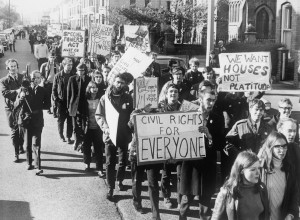 As the struggle escalated the UK government sent British troops to re-establish order. However the events of Bloody Sunday on 30 January 1972, when British troops opened fire on a civilian protest march in Derry-Londonderry, killing 26 protestors and bystanders, caused shock waves through the Irish community. As a consequence, the decision was made to cancel the London St. Patrick’s Day Parade in both 1972 and 1973. The effect of these events in Northern Ireland, rippled throughout the Irish community in Britain and the Council of Irish County Associations questioned the appropriateness of a traditional St. Patrick’s Day Parade in London The words of Mr. Luke O’Hara chairman of Clann Connacht, representing 5 county associations, aptly portray the sentiment of the time. “Every pound we can spare should go to the Distress Fund to help some of the people in the North undergoing real hardship. I don’t feel justified in going out onto the streets of what is a hostile town and being reported by a hostile press” (Irish Post, 18 Feb, 1972). Finally the Council of Irish County Associations decide that a series of religious ceremonies, particularly a prayer vigil, was more fitting than the traditional Parade of bands, floats and as many as 20,000 people marching.
As the struggle escalated the UK government sent British troops to re-establish order. However the events of Bloody Sunday on 30 January 1972, when British troops opened fire on a civilian protest march in Derry-Londonderry, killing 26 protestors and bystanders, caused shock waves through the Irish community. As a consequence, the decision was made to cancel the London St. Patrick’s Day Parade in both 1972 and 1973. The effect of these events in Northern Ireland, rippled throughout the Irish community in Britain and the Council of Irish County Associations questioned the appropriateness of a traditional St. Patrick’s Day Parade in London The words of Mr. Luke O’Hara chairman of Clann Connacht, representing 5 county associations, aptly portray the sentiment of the time. “Every pound we can spare should go to the Distress Fund to help some of the people in the North undergoing real hardship. I don’t feel justified in going out onto the streets of what is a hostile town and being reported by a hostile press” (Irish Post, 18 Feb, 1972). Finally the Council of Irish County Associations decide that a series of religious ceremonies, particularly a prayer vigil, was more fitting than the traditional Parade of bands, floats and as many as 20,000 people marching.
By March 1972 the conflict was so serious that the British government suspended the Northern Ireland parliament and enforced direct rule from London. In these turbulent times, it became increasingly difficult for Irish people in Britain who wanted to meet as groups, such as the county associations. Under the 1844 Trafalgar Square Act, organisations were required to seek permission to hold public meetings in the Square. The year 1972, saw a blanket ban of any gatherings on Irish matters from Trafalgar Square enforced under the Trafalgar Square Act.
In 1974 the St. Patrick’s Day Parade returned to London, on a much smaller scale as a strictly religious event. Through advocating this religious and non-political stance the Council of Irish County Associations maintained the London Parade throughout the rest of ‘The Troubles’. Starting just south of Trafalgar Square, the parade often followed a route through central London from Horse Guards Parade to Westminster Cathedral. Early Sunday mornings before and after mass held at Westminster Cathedral were quiet times in central London and the location and timing of the parade would help in ensuring the parade would go on, when it was not popular to be Irish marching through the streets of London.  
There was often a large police presence on the Parade during ‘the Troubles’.  This was in part to assure the safety of the marchers, even though many of the Irish people marching felt that they were being monitored by the often overwhelming number of police on the parade.   
With the British government and troops becoming increasingly active in Northern Ireland, the Irish Republican Army, (IRA) launched a bombing campaign that targeted public areas on the British mainland. On October 5, 1974 bombs were placed in two pubs in Guildford, Surrey, southwest of London. Located close to the Pirbright barracks, the pubs were regularly frequented by soldiers and the explosions resulted in 4 soldiers and one civilian being killed. The following month on November 21 1974, bombs were place in two central Birmingham pubs, which resulted in the deaths of 21 people. The British government responded a week later by introducing the Prevention of Terrorism Act, which allowed suspects to be detained without charge for up to seven days. Under this new system of policing, three men and one woman were arrested for the Guildford bombings and six men for the Birmingham attacks. In both cases the suspects maintained their innocence and claimed in court they had confessed only after being beaten by police. Despite this the court convicts them in both cases and they were sentenced to life in prison.
As a consequence of these events the highly popular Birmingham St. Patrick’s Day Parade was abandoned for 22 years from 1975 until 1997.  
The London Irish Festival
In 1974 the first London Irish Festival was introduced as a further celebration of Irish culture and identity. Jointly presented by the Council of Irish County Associations and the London Irish Centre, it took place on the first Sunday in July. For the first two years the festival took place at Chelsea Football Ground, Stamford Bridge and thereafter moved to the larger, less restricted grounds of the 30-acre Roundwood Park in Willesden. The Festival proved an enjoyable day out with bands brought over from Ireland, exhibitions of Irish dancing, sporting competitions of Gaelic Football, hurling and camogie. An array of county association stalls sold home made bread, cakes, county scarves, hats, badges and Irish goods.
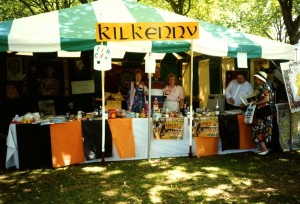 The Festival developed into a major fundraising event, through which the Council of Irish County Associations was able to financially support the London St. Patrick’s Day Parade and the work of Irish welfare organisations in London, in particular the London Irish Centre. Support in-kind helped make the Festival financially feasible, from Brent Council providing Roundwood Park free of charge to Irish airlines flying over Irish bands. While county association members were the real driving force, giving their time voluntarily, stewarding the event, cooking breakfasts for performers, and providing a floor for musicians to sleep on- all ensuring maximum profits for charitable causes. For over ten years, local business Killarney Motors in Neasden donated a car to be decorated and raffled, and at its height 18,000 raffle tickets were sold for the one car (Harrison, 2004).
The Festival developed into a major fundraising event, through which the Council of Irish County Associations was able to financially support the London St. Patrick’s Day Parade and the work of Irish welfare organisations in London, in particular the London Irish Centre. Support in-kind helped make the Festival financially feasible, from Brent Council providing Roundwood Park free of charge to Irish airlines flying over Irish bands. While county association members were the real driving force, giving their time voluntarily, stewarding the event, cooking breakfasts for performers, and providing a floor for musicians to sleep on- all ensuring maximum profits for charitable causes. For over ten years, local business Killarney Motors in Neasden donated a car to be decorated and raffled, and at its height 18,000 raffle tickets were sold for the one car (Harrison, 2004).
Congenial and celebratory in tone, the focus of the Festival was always as an enjoyable family day out, and many speak of the chance to meet up with old friends and family, sometimes for the first time in many years. Over the years the Festival grew in scale and at its height included mass at 10.00 am, followed by a grand parade of the county associations marching under their banners to the park. Separate stages accommodated both traditional and folk music, ceili and step dancing at one end of the park, and amplified bands from Ireland at the other. In 1981 it is estimated that 80,000 people attended the festival (Harrison, 2004).
Unsurprisingly in turbulent times, the Irish Festival was not without the rare occasion of trouble. Tensions ran high within the Irish in Britain particularly over concerns for justice in relation to the Birmingham Six and Guildford Four in England and the hunger strikers in Northern Ireland. In the case of the latter, imprisoned Irish republicans went on hunger strike in protest against the British government’s classification of them as criminal rather than political prisoners. Their cause drew world-wide attention when one hunger striker Bobby Sands, was elected a Member of the British Parliament before he died in prison in May 1981.
A tension surfaced between the non-political stance of the Council of Irish County Associations and Irish organisations that wanted to highlight these campaigns to the audience that attended the Festival and Parade. The complexities of this situation are acutely illustrated when in 1988, the Council of Irish County Associations refused to allow Birmingham Six and Guildford Four campaign groups to set up stalls at the Festival. It is only a year later on 19 October 1989 that the Guildford Four walk free from prison, after the evidence against them is discredited in the Court of Appeal. Disagreement about such issues is evident within the CICA itself and although the decision to ban the groups from the Festival is upheld, the CICA does go on to make a financial contribution to the campaigns (Harrison, 2004).
Certainly the events of the 1989 Irish Festival highlight the precariousness of peaceful Irish celebration at this time. In response to a policy to prohibit the sale of alcohol in the park, festival goers arrived with ample personal supplies that later proved effective missiles against mounted police who reportedly charged into the crowd. In his oral history, John Connolly underlines the concern of the Council of Irish County Associations that organisations like the IRA may have used the Parade or Festival to instigate unrest.
Hear these stories from John Connolly, Peter Middleton, Bill Aulsberry.
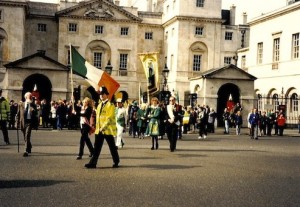 1990s -2000
1990s -2000
Throughout the 1990s the London St. Patrick’s Day Parade maintained a familiar, low-key form, marching from Horse Guards Parade to mass at Westminster Cathedral. An Irish Wolfhound, a symbol of Ireland’s history, led the Parade procession along with the St. Patrick banner, the pacer Bill Aulsberry, various dignitaries and often a marching band at the start of the Parade. In 1994 a sub-committee of the Council of Irish County Associations was formed to reenergize the Parade back to former glories, suggesting improvements to the music, floats and celebrations. Swimming against the tide of growing commercialisation, it became increasingly difficult for the Council to successfully run its charitable activities on a voluntary basis. By 2000 the St Patrick’s Dinner Dance made a loss and the costs of the London Irish Festival were climbing, with increasing fees to performers and Brent Borough Council for use of the park. Historically, both events had financially supported the Parade.
In 2001 a huge Countyside Alliance Protest, against government plans to outlaw fox hunting, was organised to rally through central London on the 18th March, the same day as the St. Patrick’s Day Parade. After a liaison with the police the Council of Irish County Associations changed the date of the St. Patrick’s Day Parade to a week earlier, the 11th March. This last minute change of date exacerbated the decline of the Parade, and numbers dwindled to there lowest at around 1500 people. The same year saw the last London Irish Festival. It finally became too expensive to undertake and after 24 years the festival that had raised £1.25 million for charitable causes came to an end.
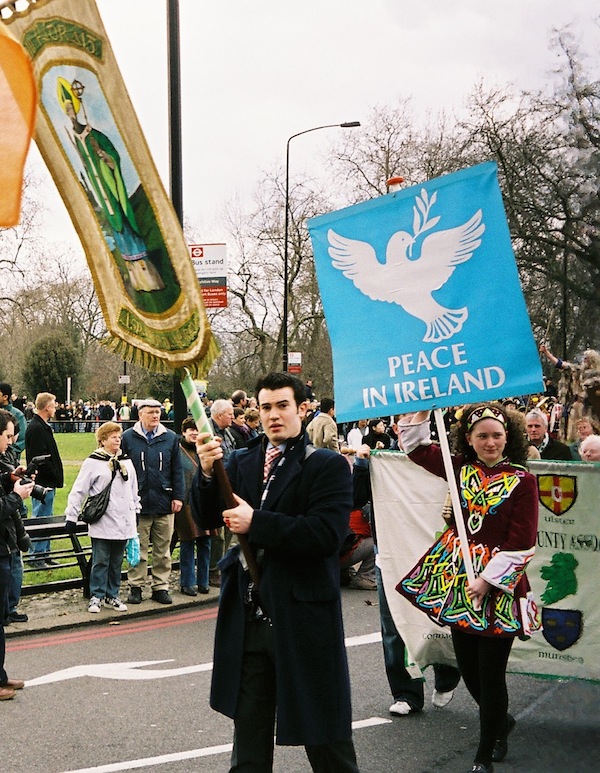 The Peace Process
The Peace Process
The Birmingham Six successfully won their appeal against miscarriages of justice and they were released on March 14, 1991 in time to join the St. Patrick’s Day celebrations. The face of the Parade began to change, along-side Irish-British relations. The 1990s witnessed a gradual change with a move towards political, rather than violent, efforts to find a solution to the conflict in Northern Ireland. It was not always easy to sustain progress, as ceasefires came and went and trust was fragile. However key moments punctuate the decade; the IRA announced a ceasefire in 1994, cross-party talks began in earnest in 1996, resulting in the Good Friday Agreement of 1998, which lay the path for a power-sharing Northern Ireland Assembly and the decommissioning of weapons.
The London Irish community and the Council of Irish County Associations supported these shifting relations. At the 1997 Annual General Meeting the Council proposed a motion to endorse the peace process and wrote letters of support to Mo Mowlan, the Secretary of State for Northern Ireland and Ken Livingstone who was at the time, the Member of Parliament for Brent East. In the following March, a few weeks prior to the signing of the Good Friday Agreement, a peace flag was carried at the head of the Parade, alongside the banner of St. Patrick.
Transition of the Parade towards a large-scale event hosted by the Greater London Authority was also part of the political choreography that helped facilitate the peace process following the Good Friday Agreement in 1998. In August 1999, Ken Livingstone made a pre-election pledge to host a London St. Patrick’s Day Parade to rival the grand parade of New York. Credited in part to his advisor Redmond O’Neill who helped draft manifesto policies on ethnic diversity and community relations in London, it was a great gesture to the Irish inside and outside of London. This public gesture of peace was later emphasized when he invited Alex Maskey, the Sinn Féin Mayor of Belfast to walk alongside him in the 2003 London Parade.
2000 to present day
Following Ken Livingstone’s election as London Mayor in 2000, the Greater London Authority worked with Irish Post publishers Smurfit Media, the Council of Irish County Associations and various other community groups to plan the biggest St Patrick’s Day celebration London had ever seen. In 2002, the Greater London Authority, in partnership with the Council of Irish County Associations started arranging a new St. Patrick’s Day parade and festival in Trafalgar Square.
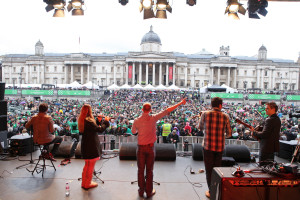
On Sunday 17th March 2002 festivities got under way when a colourful Parade set off at 1pm from mass at Westminster Cathedral and wound its way up Whitehall to Trafalgar Square. It was an historical and emotional moment for the Irish in London to march into a festival hosted in Trafalgar Square, where Irish people had been banned from meeting or gathering in the past. Mayor of London, Ken Livingstone greeted the crowd, “We are recognising the contribution that millions of Irish people have made to this city; they have helped build it, to nurse the sick in it, to educate the children in it” (The Irish World, 22 March 2002). The Square was transformed with music, crafts, dancing, stalls, Irish foods, and culture. The main stage hosted top acts including musical legends the Dubliners, joined by Mary Coughlan, Finbar Furey, and new Irish pop sensation Bellefire (St. Patrick’s Day Official Guide, 2002). The event was a phenomenal success, attracting tens of thousands of revellers to celebrate a revival of pride in being Irish, and the streets of Whitehall were turned a sea of green. With the Festival also starting at 1pm, Trafalgar Square was already over-flowing by the time the Parade arrived, inspiring a last minute decision to diverted it down The Mall.
Hear stories from Jayne Fisher, Jude Woodward, Shelagh O’Connor and Marian Larragy.
Since 2002 the London St. Patrick’s Day Parade and Festival has continued to expand, featuring in different years, a food market in Covent Garden, Ceilis in Leicester Square, a mayoral dinner dance, and the dyeing of the Trafalgar Square fountains green.
In 2014, on a gloriously sunny day, the festivities attracted a record number according to organisers, with an estimated 125,000 people attending. The Parade has become increasingly inclusive and groups that had not joined in the past are now marching together with the Counties Associations on the Parade. The Montserrat community joins the festivities, celebrating their own Irish ancestral connections and patron Saint Patrick. Bolivian and Columbian dancers, Afro-Caribbean carnival groups, Hare Krishna celebrants all bring unique creative expressions to the Parade. LGBT groups, feminists, political groups and second and third generation Irish, through the annual St. Patrick’s Day Parade and Festival celebrations, now contribute to a diverse and engaged expression of the different ways to be London Irish in the 21st century.
References:
Harrison, Gerry (2004). The scattering: a history of the London Irish Centre, 1954-2004. London: London Irish Centre.
Clare Association London, Twenty-First Annual Dinner Dance Souvenir Brochure and Menu, 1979.
The Meath Association of London, Special Millennium Gala Dinner Dance Brochure, 2000.
The Meath Association of London, Golden Jubilee Celebration Brochure, 2008.
Mayor of London St Patrick’s Day Parade and Festival Official Guide, 2002.
An ‘Amazing’ Day For London Irish by Tom Griffin in The Irish World, Friday 22 March 2002.
For further information please see our Explore More section for print and web resources

